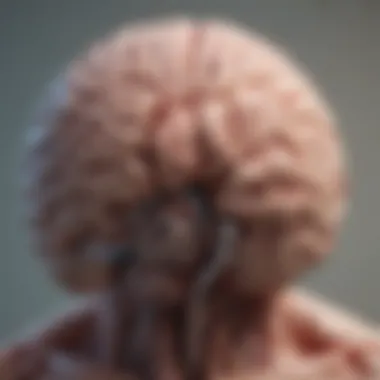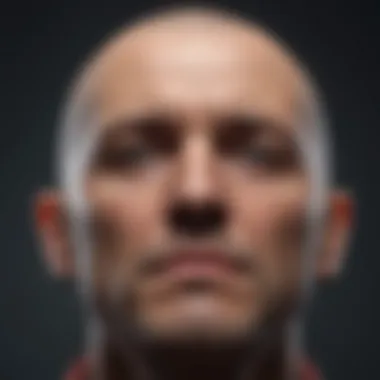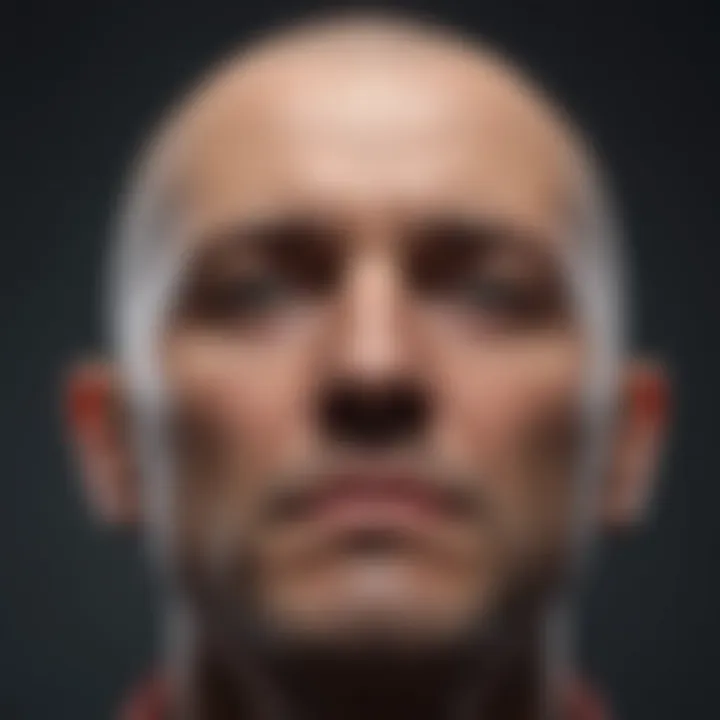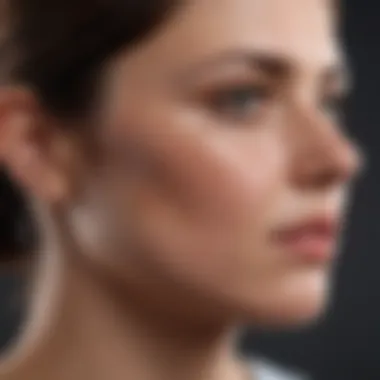Exploring Right Stroke Symptoms: Key Insights


Intro
Right strokes, also known as right hemisphere strokes, can pose significant challenges, affecting both physical and cognitive abilities. Understanding the nuances of right stroke symptoms is crucial for timely diagnosis and effective rehabilitation. This section serves as an entry point to discuss the symptoms associated with right strokes, their implications, and why having this knowledge can greatly benefit patients and healthcare providers alike.
Navigating through symptoms such as neglect or spatial reasoning difficulties is imperative as these can severely impact daily activities and interactions. Additionally, recognizing the distinctions between right and left stroke symptoms can be enlightening for those studying these conditions. This article will peel back the layers of this complex subject, aiming to clarify the pathways that lead to coherent management strategies.
As we delve into the research, keeping a keen eye on various studies and findings will create a strong foundation for understanding the broader context of right stroke symptoms, their management, and rehabilitation. So, let's take this journey into the intricacies involved with right strokes.
Research Overview
Summary of Key Findings
Research has shown a range of symptoms related to right strokes, highlighting variations in expression based on individual circumstances. Notably, many patients exhibit:
- Neglect of the left side: This means they might ignore everything on one side, which can significantly affect their mobility and awareness.
- Difficulty with spatial tasks: Such as judging distances, recognizing faces, or navigating through familiar environments.
- Changes in emotional regulation: Patients may have unexpected emotional responses like laughter or crying, not linked to their circumstances.
- Communication issues: Although right strokes are not primarily linked to speech deficits, the understanding of idioms and metaphorical expressions can be compromised.
These findings open up discussions about targeted therapies that could mitigate these symptoms.
Importance of the Research
Understanding right stroke symptoms serves a fundamental role in promoting timely interventions. Early detection can mean the difference between prolonged recovery and potential life changes. Furthermore, recognizing the unique characteristics of right strokes as compared to left strokes enables caregivers and medical professionals to tailor approaches uniquely suited for their patients. The nuances of each stroke type underscore the need for nuanced educational resources and rehabilitation programs that address specific deficits.
By grasping these concepts, students, researchers, educators, and health professionals can heighten their awareness of signs and symptoms associated with right strokes, ultimately contributing to better patient outcomes and more informed caregiving strategies.
Defining Stroke
Stroke is a critical event that can drastically alter the lives of individuals and their loved ones. Understanding what constitutes a stroke is the first step in recognizing its potential impacts and addressing its treatment and rehabilitation. Simply put, a stroke occurs when the blood supply to part of the brain is interrupted or reduced, preventing brain tissue from getting the necessary oxygen and nutrients. Without quick intervention, brain cells can begin to die within minutes, causing significant and lasting impairments.
The relevance of defining stroke in this context cannot be overstated. Awareness of the symptoms and types of stroke enables quicker response times, critical for minimizing damage and enhancing recovery outcomes. Defining stroke in detail also facilitates better communication among medical professionals, patients, and caregivers, ensuring a unified approach to treatment.
Types of Stroke
Strokes generally fall into two main categories: ischemic and hemorrhagic strokes. Here is a brief overview of each:
- Ischemic Stroke: This is the most common type, accounting for nearly 87% of all strokes. It occurs when a blood clot blocks or narrows an artery leading to the brain. Conditions like atherosclerosis, where arteries become narrowed due to fatty deposits, often predispose individuals to ischemic strokes.
- Hemorrhagic Stroke: This type occurs when a blood vessel in the brain bursts, leading to bleeding in or around the brain. The causes of hemorrhagic strokes can often be linked to high blood pressure or aneurysms. These strokes require urgent medical attention due to the immediate pressure they place on the brain.
Both types of stroke manifest differently and require distinct intervention strategies, highlighting the importance of identification.
Consequences of Stroke
The aftermath of a stroke can lead to substantial consequences, heavily impacting the affected person’s life. Outcomes typically depend on the location and size of the stroke, in addition to the speed of medical intervention. Some common consequences include:
- Physical Impairment: Strokes often affect mobility and coordination. Individuals may experience weakness on one side of their body or loss of motor function, making basic tasks challenging.
- Cognitive Deficits: Cognitive challenges can occur, such as difficulty with attention, understanding, or problem-solving. Some may also experience memory loss which can ripple into daily activities.
- Emotional Impacts: Emotional distress can emerge, including depression and anxiety, often as a response to the drastic life changes imposed by a stroke. Some individuals may also face emotional instability, making it hard for them to express feelings appropriately.
In summary, defining stroke isn’t just about understanding the medical terminology; it's about recognizing how it permeates lives, dictates recovery paths, and necessitates timely action. Attention to the detailed types and consequences lays a foundation for the insightful discussion that follows on symptoms and treatments.
Anatomy of the Brain
Understanding the anatomy of the brain is crucial when discussing stroke symptoms, particularly right stroke. The brain is an incredibly intricate organ, responsible for numerous functions that dictate everything from our motor skills to our emotions. Knowing how different parts of the brain work can significantly aid in recognizing symptoms and tailoring appropriate treatments.
Brain Hemisphere Functions
The brain is divided into two hemispheres, each responsible for distinct functions. The left hemisphere generally governs language, analytical thinking, and logic, while the right hemisphere is crucial for spatial awareness, creativity, and emotional regulation. To put it simply:
- Left Hemisphere: Deals mostly with logical reasoning and language.
- Right Hemisphere: Controls holistic thought, intuition, emotional interpretation, and more.
This division is not absolute; rather, the hemispheres communicate through a bundle of nerve fibers called the corpus callosum. Still, understanding which hemisphere does what can aid in recognizing impairments stemming from a right stroke. When this left side of the brain gets affected, patients could experience speech impairments, while damage on the right can lead to more subtle but equally challenging difficulties such as disorientation or neglect of the left side of their body.


Impact of Right Hemisphere Damage
Damage to the right hemisphere can lead to a series of symptoms that are often overlooked. While the physical manifestations, such as weakness or paralysis on the left side of the body, may be apparent, the cognitive and emotional impacts can be profound and debilitating.
- Neglect Syndrome: Often, individuals with right hemisphere damage may ignore stimuli or even visual input from the left side. This condition can be devastating as it affects their interactions with the world.
- Emotional Instability: Right hemisphere impairment can lead to mood swings, where the individual might laugh or cry inappropriately, disrupting daily life.
- Memory Issues: Short-term memory can be diminished, resulting in difficulties retaining new information.
The symptoms may not follow a predictable pattern; sometimes, a seemingly minor event may lead to significant consequences. As noted, understanding the anatomy and its complications can enhance early detection and intervention, ultimately improving rehabilitation outcomes.
"Awareness of cerebral functions allows healthcare providers to customize treatment plans. Identifying right hemisphere issues introduces the possibility of more effective interventions."
In exploring the impact of right hemisphere damage, one gains insight into the broader complexities of stroke. Understanding these dynamics not only helps in better identifying symptoms but also aids in developing comprehensive care plans that address both physical and cognitive needs.
Symptoms of Right Stroke
Understanding the symptoms associated with a right stroke is of immense significance. The way these symptoms manifest not only can affect an individual's daily life but also offers key insights into the underlying mechanisms of brain function and damage. Identifying the specific symptoms early on can lead to rapid intervention, which is paramount, as time is often of the essence in reducing the long-term effects of a stroke. Awareness of these symptoms arms friends, family, and health care providers with the knowledge needed to act appropriately when emergencies arise.
Physical Symptoms
Strength Loss
Strength loss is often one of the first symptoms noticed in individuals experiencing a right stroke. This particular aspect can lead to considerable challenges in daily tasks, making it a critical sign to recognize. A key characteristic of this symptom is the sudden onset of weakness on the left side of the body, which aligns with the right hemisphere of the brain being affected. This loss can greatly hinder a person's ability to engage in simple activities like lifting items or maintaining balance, underpinning its relevance in the context of this article.
One unique feature of strength loss from a right stroke is its potential to confuse those who witness it, as it might be misattributed to common fatigue or simply aging. The time period following its onset usually shows a stark contrast from the person’s previous abilities, raising immediate flags for the need for medical assessment.
Potential disadvantages include the emotional toll on the patient, who may grapple with frustration or a feeling of helplessness. The upswing is that, with proper rehabilitation, many individuals experience significant recovery, shedding light on the resilience of the human body.
Coordination Difficulties
Coordination difficulties pose another significant challenge for stroke survivors. This symptom often manifests as a lack of control or graceful movement, which can be disheartening for those experiencing it. The key characteristic here is that the individual may find it hard to perform tasks that require fine motor skills, like buttoning a shirt or using utensils, as the right side of the brain governs these movements. Being detailed on these challenges further illuminates the overall impact of right stroke.
Coordination difficulties might often present as a peculiar feature known as dysmetria, where a person may overshoot or undershoot when reaching for objects. This can lead to increased dependence on caregivers and require learning new ways to engage in everyday tasks. While frustrating, awareness of this symptom is beneficial in emphasizing the need for targeted therapies.
Visual Impairments
Visual impairments can severely affect the quality of life for those who have suffered from a right stroke. This symptom encompasses a range of issues from difficulty in recognizing objects on the left side of one’s field of vision to complete neglect of that area, a condition often referred to as visual neglect. The key aspect of this issue is how it complicates rehabilitation efforts since sight is a crucial element of the healing process and daily function.
Unique features of visual impairments from stroke can include not only blurriness but also distorted visual perception, leading individuals to misjudge distances or even perceive things differently than they are. It's important to note that while visual therapies can help, they may take time to yield results, illustrating the challenges involved. However, addressing visual impairments is vital as they can hinder social interactions and the overall recovery approach.
Cognitive and Emotional Symptoms
Neglect Syndrome
Neglect syndrome, or unilateral neglect, occurs when an individual fails to acknowledge the existence of the opposite side of their body or environment. This symptom carries significant implications for safety and day-to-day functioning. A hallmark of neglect syndrome is the affected individual's complete unawareness of anything happening on their left side, which can lead to dangerous situations, such as failing to notice objects or people.
This condition highlights the brain's complex workings and its impact on perception and awareness, making it a particularly compelling focus in this article. Neglect syndrome can be difficult for family members to witness, as it often leads to increased dependence and a need for long-term support strategies.
The unique feature here is how it can recovery, requiring a comprehensive approach—involving both cognitive and visual rehabilitation strategies—for improvement. While recovery is possible, the timeline can be uncertain, underscoring the need for patience and understanding.
Emotional Instability
Emotional instability is another profound symptom resulting from a right stroke. Individuals may experience unexpected swings in emotions, transitioning from one extreme to another. The key aspect of emotional instability relates to its often unpredictable nature, causing significant distress not just for the patient but also for their loved ones.
This symptom is particularly salient as it brings to light the psychological aspects of stroke recovery, emphasizing the necessity for mental health support alongside physical rehabilitation. It's unique because this instability can lead to a complete change in relationships and social interactions, making it crucial for family and friends to understand.
However, while this symptom can be seen as a hurdle, navigating through emotional instability can lead to more profound insights into personal feelings and desires. Engaging in counseling and emotional support can be beneficial in managing these fluctuations effectively.
Memory Issues


Memory issues often arise following a right stroke, manifesting as short-term memory loss or difficulties in forming new memories. These symptoms can be pivotal in understanding the brain's functioning and overall cognitive health. A key characteristic is that affected individuals may struggle with recalling recent events or have trouble following new information, significantly impacting day-to-day functioning.
For those studying right stroke symptoms, memory issues offer a notable area of exploration due to their connection to cognitive rehabilitation strategies. Learners and researchers can benefit from understanding the different aspects of memory recovery, especially how targeted exercises can lead to improvements.
The unique feature of memory loss after a stroke is that it often intertwines with emotional aspects, making the journey of recovery multifaceted. Navigating through memory loss can be frustrating, but tailoring rehabilitation to include memory exercises may help reinvigorate cognitive function.
Identifying Right Stroke Symptoms
Recognizing the signs of a right stroke is crucial in improving outcomes for those affected. As strokes can cause irreversible damage within minutes, understanding how to identify these symptoms can lead to prompt medical attention, which is instrumental in recovery. The significance of this section lies in its emphasis on early detection, which can mitigate long-term complications and even save lives. By familiarizing oneself with the indicators discussed here, students, researchers, educators, and professionals can become powerful advocates in the fight against strokes.
Warning Signs
The warning signs of a right stroke are not always glaringly obvious, and they can vary substantially among individuals. However, certain key symptoms serve as critical alerts that something is amiss. Some common signs include:
- Sudden numbness or weakness, particularly on the left side of the body.
- Difficulty speaking or understanding. Individuals might struggle to articulate words or comprehend conversations.
- Confusion, which can manifest in various ways, including an inability to follow the flow of a discussion.
- Visual disturbances, often resulting in blurred vision or loss of vision, particularly in one eye.
- Dizziness or loss of balance. Patients might experience a sense of spinning or might stagger while walking.
- Severe headache. This symptom, often described as the worst headache someone has ever experienced, can indicate a hemorrhagic stroke.
"Recognizing stroke symptoms isn’t just medical knowledge; it’s a matter of life and death. Every second counts."
Identifying these symptoms promptly can significantly impact recovery chances. Family members and bystanders are often uniquely positioned to notice changes in behavior or physical capabilities, so education about these signs can create a well-informed community eager to act swiftly.
Neurological Assessments
Once warning signs have prompted medical attention, neurological assessments become essential in diagnosing right stroke effectively. These evaluations help to determine the type of stroke, the extent of brain injury, and the appropriate treatment options. Various tests are used during assessments, including:
- CT scans or MRIs: These imaging techniques provide a clear view of the brain’s structure, revealing any areas affected by bleeding or ischemia.
- Neurological examinations: Medical professionals will assess reflexes, vision, limb movement, and coordination. They may also evaluate cognitive functions to understand the impact on mental processing.
- Blood tests: These can help identify risk factors, such as clotting disorders or high cholesterol, that could contribute to stroke risk.
- Electrocardiograms (EKGs): Heart health is a major factor in strokes; an EKG helps track heart rhythms.
Ultimately, the goal of these assessments is to map out the cognitive and physical impairments resulting from the stroke. This information is indispensable for crafting a tailored rehabilitation plan that addresses the unique challenges faced by individuals recovering from a right stroke.
In summary, identifying right stroke symptoms encompasses recognizing early warning signs and conducting thorough neurological assessments. Together, they lay the groundwork for timely intervention and comprehensive treatment, maximizing recovery potential.
Risk Factors for Right Stroke
Understanding the risk factors associated with right strokes is crucial as they play a vital role in prevention and early detection. By identifying these factors, individuals can take proactive measures to minimize their chances of experiencing a stroke. The discussion below will highlight both genetic and lifestyle factors that contribute significantly to the incidence of right strokes.
Genetic Predispositions
Genetic predispositions can be a double-edged sword when it comes to stroke risk. Certain hereditary conditions can increase an individual's likelihood of having a stroke. For instance, if stroke or cardiovascular diseases run in the family, it may indicate a higher risk factor. This familial link is often attributed to shared genes that affect blood pressure and cholesterol levels. Moreover, genetic conditions like sickle cell disease may also put individuals at risk for strokes due to blood flow problems. In this article, recognizing these predispositions can help individuals understand their risk better and motivate them to engage in preventive health measures.
Lifestyle Factors
Lifestyle factors can greatly influence the risk of having a right stroke, with certain behaviors proving to be significant contributors.
Dietary Implications
First off, dietary implications relate to the consumption of high sodium and saturated fats, which can lead to high blood pressure and cholesterol. These two are well-known culprits associated with stroke risk. A diet rich in fruits, vegetables, whole grains, and lean proteins can counteract these effects.
This healthy way of eating is a beneficial choice as it promotes cardiovascular health. Packed with nutrients, antioxidants, and fibers, such a diet can lower the blood pressure and improve overall wellbeing. However, it’s crucial to note that not all diets are universally suitable for everyone, and individuals should consider personal preferences and any existing health conditions.
Physical Activity Levels
On to physical activity levels, regular exercise is often termed as a must-do when discussing health maintenance. Engaging in consistent physical activity strengthens the heart, improves circulation, and mitigates obesity. As a beneficial choice, it lessens multiple risk factors for stroke. In a bustling world, finding time for physical activity can be a challenge. Yet, it’s like hitting two birds with one stone: regular exercise promotes both physical and mental health. However, the downside could be the potential for injuries, especially if rigorous activities are adopted without proper guidance.
Tobacco Use
Lastly, let’s talk about tobacco use, which poses a significant health threat. Smoking tends to narrow blood vessels and increases blood pressure. This fact alone makes it a dangerous lifestyle choice when it comes to strokes. Regardless of any potential advantages that might come from social habits or stress relief, the harmful effects of tobacco far outweigh any perceived benefits. Quitting smoking can drastically lower stroke risk, but the journey can be tough. Support groups and counseling often serve as excellent resources for individuals looking to kick the habit.
In sum, understanding these risk factors allows for the development of targeted strategies for prevention and intervention. Knowledge is power, and those who can identify their risks are better equipped to take action toward a healthier, stroke-free life.
Treatment and Rehabilitation


Understanding stroke, specifically right stroke, is incomplete without delving into the vital realms of treatment and rehabilitation. For many, this phase plays a crucial role in recovery, making it equally important as the initial emergency medical care. Addressing both the immediate and ongoing needs of stroke survivors is essential. The process is tailored to restore functionality, enhance quality of life, and facilitate independence to the greatest extent possible.
Acute Treatment Options
Once a stroke is diagnosed, swift intervention is paramount. Acute treatments primarily focus on minimizing brain damage and preserving brain function. Commonly used methods include the administration of thrombolytics, commonly known as "clot busters". These drugs can dissolve the blood clots responsible for ischemic strokes, thus restoring blood flow. In some cases, mechanical thrombectomy, a procedure that involves physically removing the clot, may be an option. Moreover, medical staff monitor vital signs and manage any complications that may arise during this critical initial phase, ensuring that every second counts.
Long-Term Rehabilitation Processes
The long-term rehabilitation process is where the real battle begins for many stroke survivors. This phase is designed to help regain lost physical and cognitive functions through structured therapies. Rehabilitation combines various methods and highly tailored programs to meet the needs of individuals. It typically engages patients in a range of activities aimed at rehabbing different aspects of their health and life.
Physical Therapy
Physical therapy focuses on restoring movement and strength. Specific aspects of physical therapy include exercises tailored to improve gait, strength training, and balance enhancements. One distinguishing characteristic of this therapy is its individualized approach, adapting techniques to match the unique physical capabilities and progress of each patient. This customization makes physical therapy not only a popular choice but also a potent one in stroke recovery. A unique feature is the utilization of equipment such as resistance bands and parallel bars, allowing patients to safely work on their strength and coordination. However, one must be patient; recovery can be slow, and not all techniques work for every individual.
Cognitive Rehabilitation
Cognitive rehabilitation is another corner of the rehabilitation landscape. This type of treatment hones in on cognitive functions such as memory, attention, and problem-solving skills. What sets cognitive rehabilitation apart is its focus on activities that enhance mental acuity, thus fostering a quiet transformation in how patients approach daily tasks. One key characteristic is the use of gamified learning and engaging tasks to evoke brain activity. This method has proven beneficial, especially for those struggling with memory issues—a common aftermath of right strokes. However, the potential downside is that progress may take time, and some may find the subtlities of cognitive tasks frustrating at times.
Supportive Care
Supportive care wraps an additional layer around rehabilitation. This aspect emphasizes emotional support and practical assistance, creating a nurturing atmosphere essential for recovery. A key characteristic of supportive care is its holistic approach, advocating for emotional wellness alongside physical healing. Engaging social workers or counselors can facilitate communication and help address fears and concerns. The unique feature here is the focus on the patient’s environment—making necessary adjustments to home settings or daily routines helps ease transitions. However, while supportive care is crucial, it often requires resources and commitment from family and caregivers, which might not always be readily available.
"Recovery from a stroke is not just about regaining lost abilities, but also about rebuilding one’s life and relationship with self and others."
In summary, the journey of stroke recovery is a multi-faceted experience that incorporates acute treatments followed by comprehensive rehabilitation efforts. It’s essential to recognize that each survivor has a unique path, often requiring a blend of therapies to achieve the most favorable outcomes.
Differentiating Between Right and Left Stroke Symptoms
Understanding how to differentiate between right and left stroke symptoms is crucial, particularly for those who may be directly or indirectly affected by strokes. Knowing these distinctions not only enhances diagnostic accuracy but can also greatly influence treatment approaches. Stroke symptoms can vary significantly between hemispheres, leading to differences in cognitive function, physical ability, and emotional well-being. Identifying these unique elements is vital for caregivers, medical professionals, and families alike, as it shapes the path for rehabilitation and recovery.
Key Differences
Some key differences between symptoms of right and left stroke include:
- Motor Function: Right-sided strokes often lead to weakness or paralysis on the left side of the body, impacting mobility and coordination. Conversely, left-sided strokes can cause weakness on the right side, affecting how the person interacts with their environment.
- Visual Processing: Damage to the right hemisphere may lead to neglect of the left visual field. This means an individual might not perceive objects on their left side. Those with left hemisphere damage could struggle with language and comprehension, presenting different challenges.
- Emotional Responses: Right strokes often accompany difficulty interpreting social cues and expressing emotions, leading to possible emotional instability. In contrast, left strokes can impair logical processing and communication styles, affecting verbal expression.
- Cognitive Abilities: The cognitive fallout from right strokes may lead to issues with attention and spatial awareness, while left strokes frequently affect analytical skills and decision-making abilities.
These differences highlight not only the variety of symptoms that arise from stroke damage but also the need for tailored rehabilitation approaches suited to the affected hemisphere.
Clinical Implications
The clinical implications of distinguishing between right and left stroke symptoms are substantial. For one, they directly influence assessment methods and potential interventions. Medical professionals must utilize accurate neurological assessments to uncover which hemisphere has been compromised. This specificity allows for targeted therapies and rehabilitation aimed at the areas most affected by the stroke.
Moreover, recognizing these differences can significantly impact patient support systems. For example, an individual with a right-stroke may require family members and caregivers to be more attuned to their emotional needs and potential for frustration due to perception issues. In contrast, those recovering from left strokes might need assistance with communication and cognitive tasks.
Understanding these clinical implications is fundamental in improving patient outcomes. When healthcare providers can clearly delineate between the consequences of right versus left strokes, they are better equipped to offer comprehensive care strategies that are effective for each patient’s unique circumstances.
Finale
The conclusion of this article sheds light on the significance of recognizing right stroke symptoms and the broader implications for both individuals and healthcare systems. Grasping these symptoms is not merely a matter of academic interest; it's about transforming awareness into action. The knowledge gained can save lives, improve recovery outcomes, and enable timely interventions.
The Importance of Awareness
Awareness plays a pivotal role in understanding right stroke symptoms. It's essential for several reasons:
- Early Detection: Recognizing symptoms early is key. Symptoms such as weakness on one side or cognitive difficulties can often be misconstrued or dismissed. An early alert can hasten treatment and enhance the chances of a better recovery.
- Empowerment: Educating those around us—including family members and communities—can empower people to act quickly in an emergency. This understanding extends beyond just individuals at risk; it's a communal effort.
- Reducing Stigma: There’s a stigma associated with stroke that often leads people to shy away from discussing it. Elevating awareness challenges these notions, encouraging open conversations surrounding strokes and their symptoms.
Future Directions in Research
As we move forward, future research efforts must encompass various aspects of right stroke symptoms and treatment.
- Potential Biomarkers: Identifying biomarkers that could signal the onset of a stroke might revolutionize diagnosis. Early diagnostic methods using blood tests or imaging could make a world of difference.
- Neurological Rehabilitation: Investigating new approaches to rehabilitation techniques, especially considering the specific impairments from right hemisphere damage, can offer valuable insights into enhancing recovery. For example, customized cognitive therapies may yield improved outcomes for affected individuals.
- Longitudinal Studies: Further studies tracking patients over time will help understand the long-term consequences of right stroke. Such data could inform better rehabilitation protocols and help predict recovery trajectories.
The conclusion, therefore, underscores not only the importance of understanding symptoms but delves into the continuous journey of research, awareness, and education surrounding right stroke and its many dimensions.



